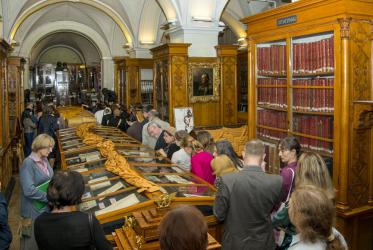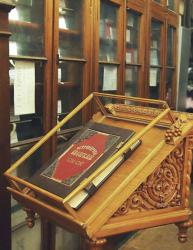Foundation Collections of the Manuscripts Department. Pyotr Dubrovsky
The department's history may be traced through the development of its priceless holdings. In their turn, they, like in a multi-faceted mirror, reflect the history of Russia and a whole kaleidoscope of people who left their mark on world culture, book lovers with their wonderful collections, and the fates of that collections.
The first manuscripts, intended for the Imperial Public Library, appeared in St. Petersburg even ten years before the creation of the department. At that time, 11 thousand manuscripts was brought to St. Petersburg as part of the Zaluski Brothers Library after the Third Partition of Poland by Catherine II's decree. According to the terms of the Treaty of Riga, almost all the books from the Zaluski Collection were returned to Poland between 1922 and 1935, and most of them were lost during World War II.Actually, the rescript of Alexander II of 1805 on the establishment of the Manuscripts Depository was related to the acquisition of the outstanding Dubrovsky Collection by the Government.
Having neither significant resources nor high official position, Pyotr Dubrovsky amassed about 900 manuscripts, dating from the 5th to 18th centuries, while serving as the secretary and interpreter with the Russian Embassy at Paris. His very valuable and extensive collection comprises over 700 Western European, 50 Slavic, 20 Greek and more than 130 Oriental books and 15 thousand papers of the 12th – 18th centuries.During the French Revolution, his collecting activities blossomed. That was when Dubrovsky had managed to acquire many valuable manuscripts from the rich library of the abbey of Saint-Germain-des-Prés, including the ancient Latin manuscripts created in the monastic scriptoria of West-European monasteries during early Middle Ages. Among them is the Collected Works by Saint Augustine, the oldest Latin codex in possession of the National Library of Russia. Scientists consider the copy to be created during the 5th century in Hippo, small Northern African town, where Saint Augustine was ordained bishop. It is quite possible that at the end this text bears the actual autograph of Saint Augustine.
No less unique is the Ecclesiastical History of the English People by the first English historian, the Venerable Bede (died in 735). This second oldest surviving copy was created near 746, 10 years after the death of the author.
The Dubrovsky Collection includes magnificent illustrated manuscripts that has come from the libraries of kings or other members of the royal families, great nobles of England, France, Italy, and Spain. An excellent example of 14th-century French book art is Petrus Comestorus's Scholastic History translated from Latin by the canonic Guiart des Moulins. This two folio volumes belonged to the d'Albrets, the house of Navarre, for two centuries. The Dubrovsky Collection also contains extensive documentary material of great historical value, mainly, the 16th-18th century papers stored in the state archives of France, including the archives of the Bastille.
Initially, the new Russian repository for ancient manuscripts grew through the donations of private individuals. One year after the purchase of the Dubrovsky collection, Alexander I transferred to the Depository the famous Ostromir Gospel, the oldest dated Russian manuscript book. In 1810, the assistant to the manuscripts keeper A. Ermolaev, presented the library with a copy of the Ipatiev Chronicle. In 1811, Count Aleksei Musin-Pushkin presented the Library with the Laurentian Chronicle of 1377, containing the oldest copy of The Tale of Bygone Years. Thus saved the unique manuscript from loss in the Moscow fire of 1812 (during the Napoleonic occupation), which burnt out Musin-Pushkin's entire library, largest at that time, together with the only copy of The Tale of Igor's Campaign.
After the official opening of the Public Library "to everyone's benefit" on January 2 (14), 1814, the depository received 64 manuscripts as a gift within 11 months. Alexander I brought from Paris a richly illustrated book, dating 1401, with the French translation of the Latin writer Valerius Maximus, author of a collection of historical anecdotes. Noteworthy among the gifts are two volumes of the great 16th century Illustrated Chronicle of Ivan the Terrible: the Chronograph Miscellany (donated by the Greek nobleman Z. Zosimus) and the Shumilov Volume (donated by the Tomsk merchant Mefody Shumilov).

